I Tried the Most Popular Entrées at Panda Express & One Reigns Supreme
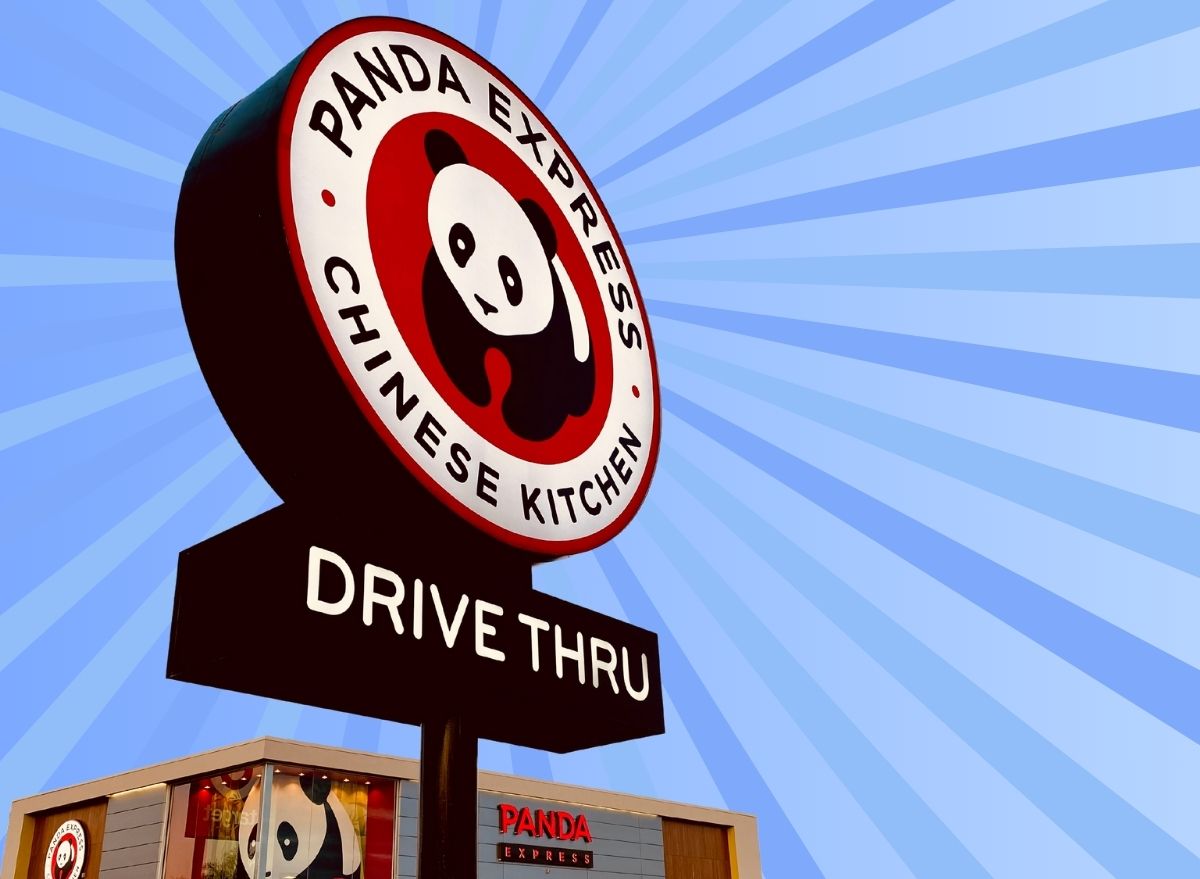
Born in 1983, Panda Express now stands as one of the largest Asian food concepts in the country with more than 2,300 locations. Its red, white, and black logo is often seen by busy travelers as they make their way through the airport or drive down the interstate. With so many locations, Panda Express is ready to serve you Chinese-style food straight from the wok, pretty much wherever you are.
The chain is inspired by Chinese regional cuisine, but the dishes at Panda Express tend to be more Americanized. The chain's stint in the burrito game back in 2022 is a perfect example of its willingness to experiment. Consumers eat up what Panda serves, despite the lack of authenticity.
As is the case with any restaurant or fast-food business, the franchise has signature dishes that stand out from the rest—the chain's cash cows or cash "pandas," if you will. I had a few ideas for what these might be for Panda, but I went straight to the source to confirm my suspicions.
A representative from Panda's PR team said that the five top-selling entrées at the restaurant are (drumroll please): Beijing Beef, Broccoli Beef, Honey Walnut Shrimp, Mushroom Chicken, and, of course, the Original Orange Chicken—the dish that Panda Express is credited with inventing.
All five of the top-dog dishes can't share the podium. To find out which one is the tastiest the chain has to offer, I gave each one a try. All were ordered in bowl form, which comes with a choice of one side (chow mein, fried rice, white steamed rice, or super greens) and each cost $8.30—except for the shrimp, which came at a small up-charge. Let's dig in and see which one had good fortune.
Here's how each dish stacked up, ranked in descending order from my least favorite to the tastiest entrée of all.
Broccoli Beef
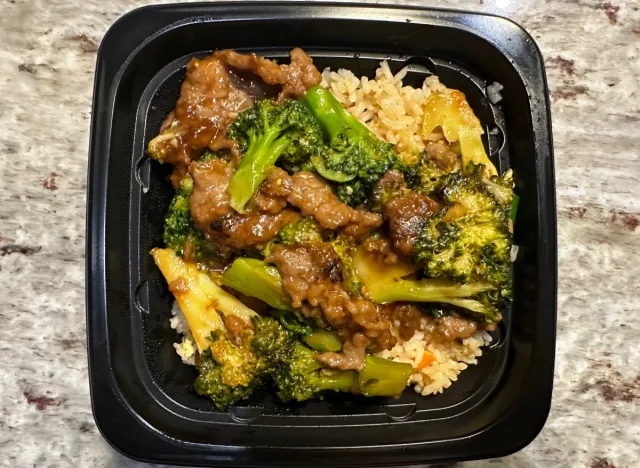
The Broccoli Beef at Panda Express is considered a "Wok Smart" choice. This means it contains at least nine grams of protein and no more than 300 calories. The real calorie count is at 150 calories for a standard bowl size, the lowest of all entrées in this survey. It's also one of the simplest dishes at the chain, consisting of tender beef mixed with broccoli florets and tossed in a light ginger soy sauce. In my personal experience with this dish, the ratio of broccoli to beef tends to be a little off—probably why its calorie count is so low. But, I was ready to give it another go alongside a helping of fried rice.
The look: My memory didn't fail me, as this dish was once again exceedingly broccoli-heavy. I counted six small strips of brown beef nestled among sizable pieces of the green veggie. The meat is also sliced thinly, and everything is coated in a reddish-brown or copper-colored sauce.
The taste: For me, this one falls flat. Not only is there not much beef to go around, but it's also gamey and lacks robust flavor. If you told me the sauce for a dish was basic beef broth, I would believe you. As for the broccoli florets, they are large and awkward to eat. Their massive size may explain why some of the stems were undercooked and nearly too hard to bite into. The honey soy sauce—and the entire bowl—tastes like a meal I could have whipped up at home, and probably done better. So, for these reasons, it landed at the bottom of my list.
Honey Walnut Shrimp
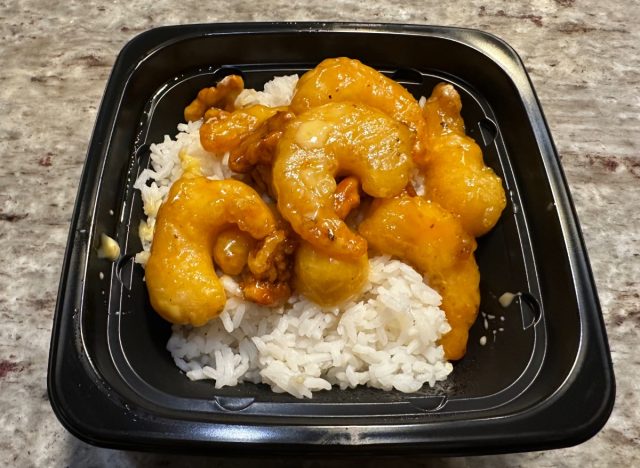
Cooked up in 2010, Honey Walnut Shrimp is one of the more recent entrées to join the Panda Express lineup. It's also one that saw near-immediate success. The dish is said to have originated in Hong Kong, where British influence pops up in the cuisine.
In the chain's recipe, the mayo combines with a honey sauce and is then coated onto hearty-sized pieces of tempura-battered shrimp. After cooking in a wok, glazed walnuts are thrown in for crunch. I struggled to pick a side I thought went best with this one, but I ended up with steamed white rice for a neutral base. It's important to note this is a premium entrée, so it costs $1.50 more than other entrees for a total of $9.80.
The look: Orange creamsicle-colored breaded shrimp. There were seven total sitting atop the white rice, which made for a light portion, but all were ample-sized. The glaze is evenly spread and not overly applied. Only five walnuts could be found, so I cut some in half to spread them around.
The taste: The batch I received was fresh from the wok, so it was sizzling and warm when it reached my bowl. The shrimp was teetering towards underdone, with a mucousy texture. I would have preferred something a tad more firm. The dressing is sweet from the honey, but the creamy mayonnaise dominates this dish in a way that doesn't scream Chinese food to me.
What would have made this dish better is another handful of walnuts. They are candied like the kind you buy at a fair, with a soft crispness. I could have eaten an entire bowl of the nuts alone.
Mushroom Chicken
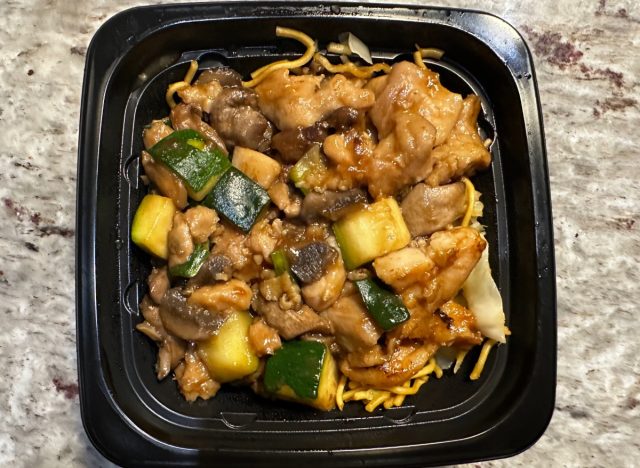
Chicken and mushrooms are a classic combination that can be seen in recipes from around the world. Chicken marsala is an Italian-inspired example. Coq au vin from France often marries the two. In Chinese cuisine, the chicken and mushrooms come together in stir-fries, soups, and more.
Panda Express offers a simplified version of the pairing, with its Mushroom Chicken. In the entrée, both ingredients are bathed in ginger soy sauce and joined by zucchini. As a more veggie-forward choice, it's also a "Wok Smart" choice–similar to the Broccoli Beef–with 220 calories. Of course, that measurement is taken before you add in your choice of side, which for me was chow mein (a 510-calorie addition).
The look: Probably the least appealing entrée of the bunch. Tan pieces of chicken meld together with the gray mushrooms, making it hard to identify what is what. Without the bright green zucchini chunks, it would be a jumbled mess of lusterless ingredients.
The taste: Light and fresh—a pleasant surprise given its not-so-appetizing appearance. This entrée and the Broccoli Beef are the only two that don't come fried, and it's a nice change of pace. I could devour this entire bowl without feeling gross and like I need to lie down for the next two hours. The white meat chicken is finely cut, but tender enough to almost melt in your mouth. And, the mushrooms are juicy and not overly mushy. I'm a sucker for a good sautéed and saucy mushroom, and these hit the nail on the head. I could have done with or without the zucchini. But, it was cooked well and I can appreciate a bonus serving of veggies.
Beijing Beef
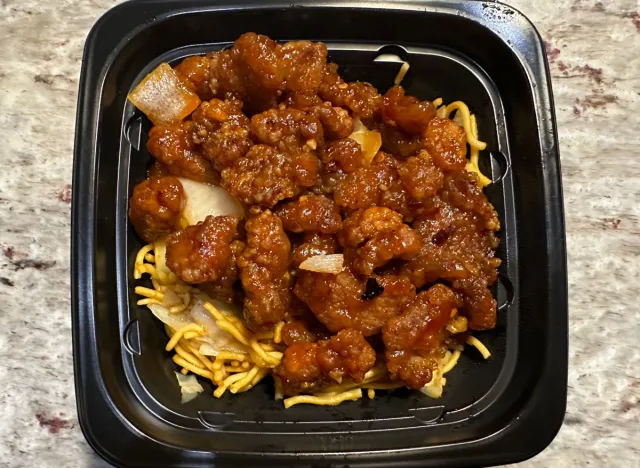
In 2008, things heated up at Panda Express with the introduction of the spicy Beijing Beef. The chain explains that the dish is named after the country's capital, where lamb and beef are common and play a part in recipes and daily meals. The entrée uses beef that is crisped similarly to the Orange Chicken. Bell peppers and onions add color, and the sauce is tangy and sweet but also has a nip of spice thanks to the added chilies. I ordered it served on top of chow mein noodles.
The look: Tiny nuggets tossed in a fair amount of deep amber or rust-colored sauce. Some pieces were so small I wondered how any beef could be hiding underneath the breading. But, all look like they pack some heat. Small squares of onion can be seen. I had to dig a bit to get to any peppers—which were orange and not red like what is shown on the Panda Express website.
The taste: The piquant smell all but singed my nose hairs, but the taste isn't offensive. The bell peppers are where I noticed the spice most. I think they are better at soaking up the seasoning and sauce. The sauce tasted like the standard sweet and sour, and its sticky nature helped it adhere to everything it touched, including the beef, veggies, and noodles I paired it with. The beef itself was hard to identify underneath all the breading—which wasn't overwhelmingly crunchy—and as I worked through the bowl, I kept thinking I was eating chicken. But, all in all, it's an entrée that I would order again.
The Original Orange Chicken
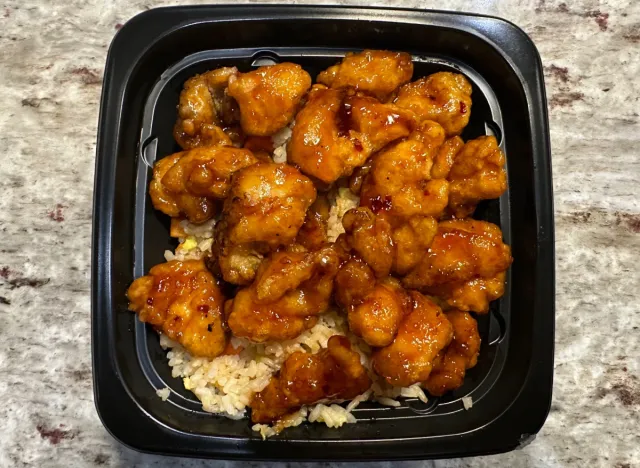
Which came first, the chicken or the fame? Technically, Panda Express opened its doors a good four years before inventing the Original Orange Chicken. But, the dish unmistakably acted as a catalyst for the chain's success, and it now stands as the poster child of the entire franchise. It is a tried-and-true moneymaker entrée, racking up the highest amount of sales each year. The chain sells more than 115,000 million pounds of Orange Chicken every single year, according to NBC News.
The recipe is inspired by the Sichuan region of China with its inclusion of Sichuan pepper and citrus. Dried chilies provide a touch of mild spice, and each piece is marinated before being deep-fried and cooked in a wok. I paired a bowl of the high-profile entrée with fried rice.
The look: Mouthwatering, I'm not going to lie. Each chicken chunk is plump and shining in a shade of orange-red, and small flecks of dried chilies can be seen on most clumps. This dish also has to be the best bang for your buck, with the heartiest portion of meat. I counted close to 20 pieces in my bowl.
The taste: It's the best-selling Panda Express entrée for a reason. Full transparency, I was secretly rooting for some of the other dishes on this list to step up. (After all who doesn't like a good underdog story?) But, the Original Orange Chicken prevailed. This batch happened to be especially crispy with moist, flavorful chicken. It also takes on a very acceptable ratio of about 60 percent chicken to 40 percent breading in most pieces. The sauce is where the dish excels. I wouldn't say it's spicy. It is savory and bold, while also showing off some sweet and zesty notes.
I've had the orange chicken at my fair share of Chinese restaurants—both takeout joints and more formal establishments—over the years. And, I can confidently say that Panda Express creates one of the best renditions in the game.









